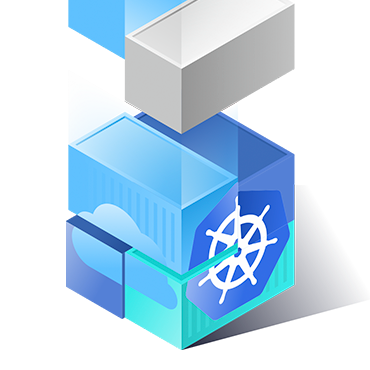What is Kubernetes? Applying Kubernetes in Cloud Solutions
Updated 15 Sep 2022
Microservices architectures built on containers have significantly altered how modern software is deployed and tested by development teams. By making it simpler to scale and deploy apps, containers assist businesses in becoming contemporary, but by establishing a completely new infrastructure environment, containers have also brought forth newer difficulties and increased complication.
Thousands of container instances are being deployed every day by a large variety of software organizations, and they must take care of the complexities of that size. So, how do they manage to accomplish it?
Introducing Kubernetes.
What is Kubernetes, and what is Kubernetes used for?
Kubernetes is an open-source container orchestration technology created originally by Google with the goal of automating the deployment, scaling, and administration of containerized applications. As many ask, “what is a container Kubernetes?” Hopefully, that explains it. As the flagship project of the Cloud Native Computing Foundation (CNCF), serverless Kubernetes has become the de facto industry standard for Kubernetes container orchestration and is supported by major companies, including Kubernetes Google, AWS, and IBM. For those asking, ”what is K8s?” It is just another name for Kubernetes.
Application deployment and management in a microservice architecture are made simple by Kubernetes. In order for development teams to deploy their apps and for Kubernetes K8s to handle the following tasks, it accomplishes this by building an abstraction layer on top of a collection of hosts.
- Limiting the use of resources by a team or an application
- Distributing the load of an application across a hosting infrastructure uniformly
- Automatically distributing requests across an application’s several instances
- Monitoring resource limitations and use to prevent apps from using up too much resources and immediately restarting them
- If a host runs out of resources or dies, moving an application instance to another host is possible.
- Using extra resources that become available when a new server is introduced to the cluster automatically
How does Kubernetes work?
The cluster is Kubernetes’ main building block. A cluster is made up of several physical or virtual machines, each of which performs a specific task as either a master or a node. Your applications are hosted in groups of one or more containers on each node, and the master coordinates with nodes to determine when to construct or remove containers. It also instructs nodes on how to reroute traffic in accordance with the updated container alignments. ALl of this can be easily managed via the Kubernetes dashboard.
Hetzner cloud Kubernetes
Kubernetes Hetzner is a low-cost supplier of cloud computing services. It is a German company that is suitable for putting up a Hetzner Kubernetes Cluster Lab because of its excellent VPS servers and low rates.
Applying Kubernetes in Cloud Solutions
The arrival of Kubernetes altered perspective of the cloud. The notion of app deployment and operation became simple and efficient thanks to this approach. Kubernetes has experienced tremendous growth during the past six years. This piece of technology has succeeded in becoming the foundation of all contemporary software as a result. Effectively, it has altered how software and apps are put into the cloud and how to get around it.
In this situation, teams from different businesses may operate freely and effectively thanks to the Kubernetes serverless architecture for the cloud platform. In essence, this realigns and streamlines organizational objectives. As a result, Kubernetes has become the norm for orchestrating and managing containers for cloud deployment and operations in the majority of enterprises.
This opens the door to a number of advantages for the firm in issue. One of these entails a quicker product release schedule. Additionally, it makes it easier for the team members to concentrate on the primary objectives of the organization and spend less time worrying about technical issues and other operational matters. It is simpler for items to get to markets thanks to the upgraded infrastructure.
The goal of Kubernetes is to change more than simply how applications are delivered in the cloud. Here, modernizing architecture is more important than anything else. For instance, corporations were often apprehensive of orchestration prior to the introduction of Kubernetes a few days ago due to the unavailability of essential capabilities.
These orchestration tools are now readily available to them thanks to Kubernetes, which has altered the fundamentals of cloud platform deployment. Such tools as mariadb Kubernetes, Keycloak Kubernetes, elasticsearch Kubernetes and Kubernetes Kafka are utilized to automate container deployment, scaling, and operation across host clusters. Kubernetes is effectively here to stay and ought to be the foundation of the software in the future when all these elements are taken into account.
The first choice from Running Apps On The Cloud
Since Google launched this gateway in 2014, Kubernetes s3 has grown in popularity. Since this Kubernetes platform is open-source, cloud users have discovered many uses for it. Due to the years of support it has received, Kubernetes quickly rose to prominence and is now the platform of choice for the majority of cloud service providers.
The uptime records for this Kubernetes manager container platform are the finest. Additionally, the cross-platform development tools of this specific solution are well-known. These are only a few instances of Kubernetes’ integration with cloud service providers. Kubernetes features and systems are currently supported by all cloud service providers worldwide.
Companies from all around the world are now working very hard to run their apps on the Kubernetes platform. One of the main causes of this is that with this platform, market deployment times may be shortened. This is a result of more effective app development processes. In practice, it also opens the door for the optimization of IT costs. All of this may be credited to lower infrastructure costs and effective development techniques. The increased scalability of Kubernetes is a key factor driving businesses to run their applications on it. Kubernetes is renowned for automatically scaling apps and enhancing their usability.
The versatility of Kubernetes with various cloud providers is a key element in its success and high adoption rate. The ability of Kubernetes to guarantee a smooth transition from one provider to another is the other part of cloud provider flexibility. In this case, the idea of vendor lock-in is eliminated. If you have been utilizing a specific cloud provider’s services with Kubernetes for a long time and want to switch to another platform, you may do so without any problems. Your company is therefore not limited to a particular cloud platform.
Conclusion
Before Kubernetes, access to the cloud was restricted and proprietary. This indicates that access was restricted and that not everyone could utilize the cloud’s architecture and interface. The main difficulty or barrier for people utilizing the cloud is the license or membership charge. Furthermore, since the cloud is proprietary, it can’t always be modified to fit the needs of the end users.
Kubernetes makes sure that your company operations are never impeded as a result of this change in the cloud interface by providing simple portability services. One of the main benefits of Kubernetes technology is cloud migration.
The use of cloud computing is increasing daily. Now that Kubernetes is operational, it is more crucial than ever to remove obstacles between cloud service providers and advance this specific technology’s accessibility and acceptance.
Future cloud and devops Kubernetes technologies will aim to do this. As a result, it becomes easier to deal with numerous cloud platforms, operate across them, or even transfer from one platform to another as per demand. Over the next several years, Kubernetes wants to cross boundaries between various cloud service providers.



